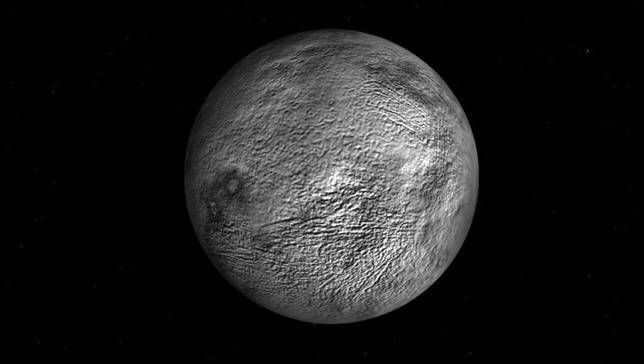
The biggest planets in our solar system
Our universe is the vast expanse that surrounds us. Space is not simply empty; it is brimming with a multitude of objects including stars, planets, nebulae, galaxies, black holes, pulsars, and quasars.
What is visible to us is only a fraction of what is out there, thanks to the latest technological advancements. The portion that can be observed using the most powerful telescopes is referred to as the visible Universe. Beyond our consciousness and comprehension lies a realm that remains unknown to us. However, in this discussion, we will focus on the largest planets in our solar system.
Erida, measuring 2,340 kilometers in length
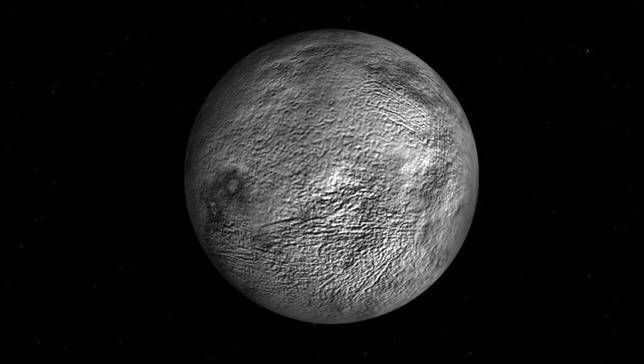
Erida is one of the largest known dwarf planets in our solar system. It is approximately the same size as Pluto, but located three times farther away from the Sun.
When Erida was initially discovered in 2005, astronomers believed it to be much larger than Pluto, and there were even speculations about Erida potentially being the 10th planet in our solar system.
However, the eventual realization that Erida is a comparatively small planet was a significant factor in the decision to downgrade Pluto to a dwarf planet in 2006. This decision continues to be a subject of controversy, highlighting the significance of Erida’s name.
What is the largest planet in the solar system?
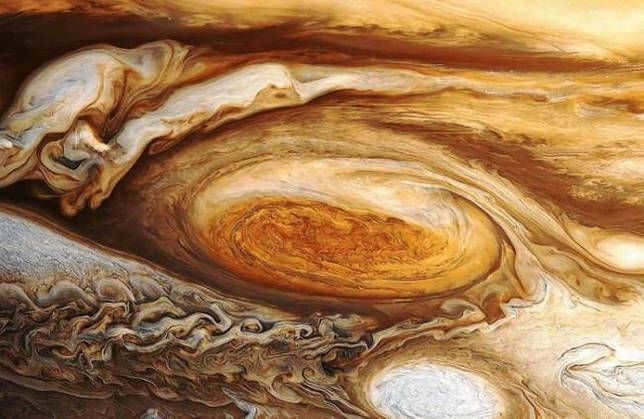
Jupiter currently has a total of 67 satellites. Among these, the most prominent are the Galilean moons, which were named after their discoverer Galileo Galilei. These include Io, Europa, Ganymede, and Callisto.
Exploring the Solar System: An Overview of the Planets
In ancient times, there was a belief that the Earth was the center of the universe, with the Sun, the Moon, and the other planets revolving around it. The heliocentric model of the solar system, where the Sun is at the center, was first proposed by the ancient Greek astronomer Aristarchus of Samos in the 3rd century BC. However, this idea did not gain much popularity at the time. It was only nearly 1800 years later that the heliocentric model was further developed by the Polish scientist Nicolaus Copernicus. In 1543, he successfully demonstrated that the Earth rotates on its axis and orbits around the Sun, just like the other planets.


A picture of Nicolaus Copernicus. Source: Wikimedia
In ancient times, the planets Mercury, Venus, Earth, Mars, Jupiter, and Saturn were discovered. All the planets, except for Earth, were named after the gods of ancient Rome, representing commerce, love, war, the supreme thunder god, and time. It wasn’t until 1781 that Uranus was discovered by the English astronomer William Herschel, who named it after the god of the sky. The discovery of Neptune in 1846 was credited to German astronomers Johann Gottfried Halle and Henry Louis d’Arré, and it was named after the god of the seas. In 1930, Pluto was designated as the “Ninth Planet” by American astronomer Clyde William Tombaugh. The planet’s name was suggested by Venetia Burney, a schoolgirl from Oxford, who thought the Roman version of the Greek god of the underworld would be a fitting name for a distant and cold planet.
The name “Earth” literally means “soil,” and it is referred to as “Terra” or “Earth” in all languages.
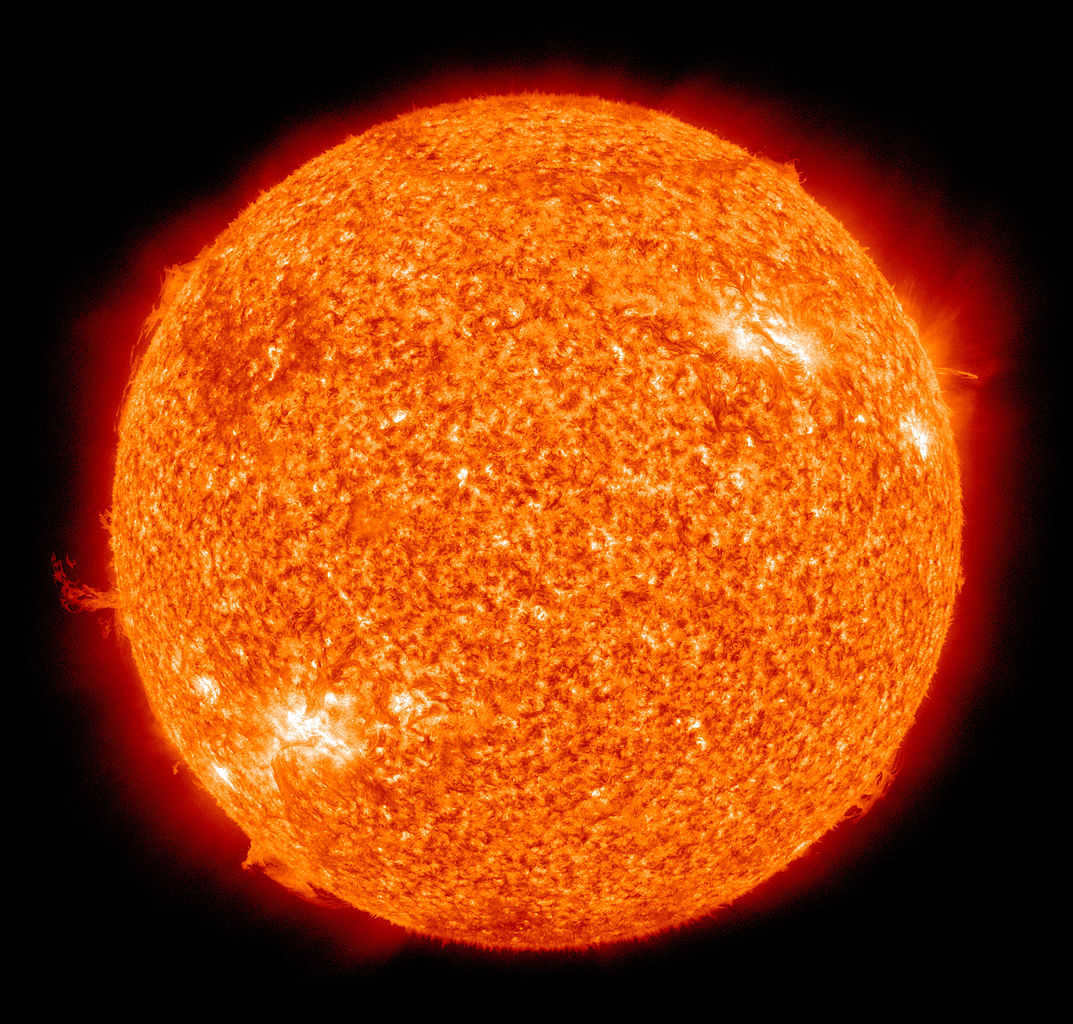
Sun. Photo: Wikimedia
In modern times, it is widely accepted that the solar system is a constituent part of the Milky Way galaxy. The central star, known as the Sun, holds the lion’s share of the system’s mass, approximately 99.86%, and exerts its gravitational pull on all other celestial bodies within the system. Interestingly, the giant planets – Jupiter, Saturn, Uranus, and Neptune – account for a considerable 99% of the remaining mass.


The Milky Way Galaxy. Image credit: Wikimedia/NASA
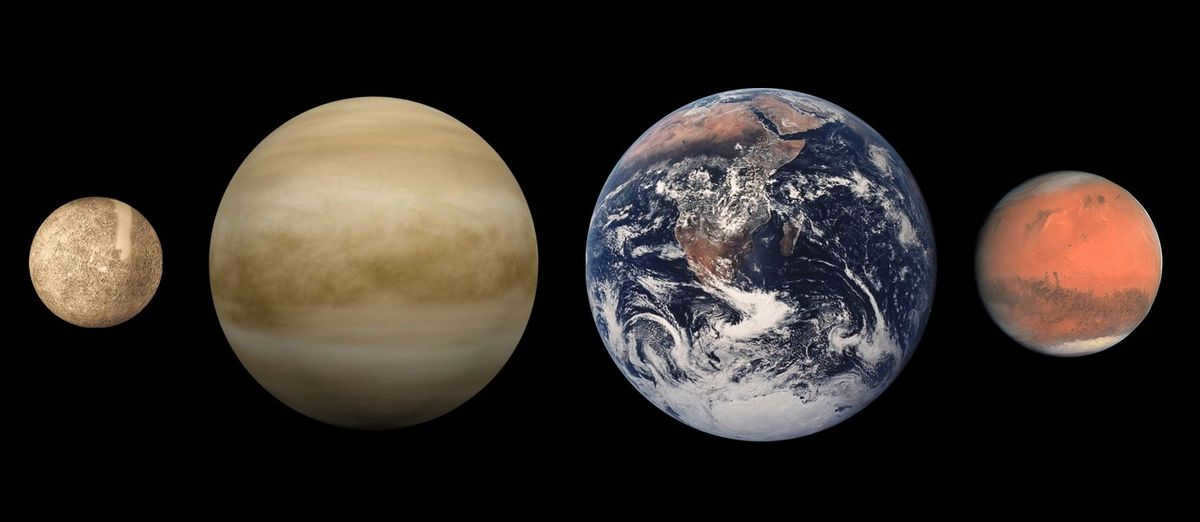
Photograph of the planets in the Earth group. Source: Wikimedia
After the asteroid belt, there is a region in the solar system that consists of Jupiter, Saturn, Uranus, and Neptune, along with their respective rings and satellites. This region also encompasses comets, distant asteroids, and dwarf planets, such as Pluto.
The Ice Giants: Uranus and Neptune
Uranus and Neptune are two celestial bodies categorized as Ice Giants. They are often referred to as twin brothers due to their striking similarities in various characteristics.
Uranus, being the seventh planet from the Sun, holds the title of the third largest planet in our solar system. It boasts a substantial number of satellites and is encompassed by a remarkable system of rings.
Initially discovered in 1781 by William Herschel, Uranus was initially mistaken for a comet. The planet is known for its highly displaced axis, causing it to appear as if it is lying down. A single year on Uranus spans a staggering 84 Earth years.
Similar to other gas giants, Uranus is predominantly composed of helium and hydrogen. However, beneath its gaseous outer shell lies a mantle made of ice, with a solid rocky core at its center.
The layers of atmosphere surrounding this icy giant consist of various chemical components:
Uranus’ rings are composed of small particles. There are a total of two inner rings and eleven outer rings that formed during the explosion of the ancient satellites.
In 1986, a mission was conducted to Uranus.
Neptune, which is the eighth planet in the outer system, was discovered relatively recently in 1846. It was named after Neptune, the god of the seas. It has a rapid rotation around its axis, completing a full revolution in 18 hours. It is smaller in size than Uranus but more massive. Neptune is the farthest planet from the Sun.
Beneath its dense atmosphere, there are layers of hydrogen, methane gases, and helium. Additionally, there are also ammonia, water, and methane ice present. Underneath the mantle lies a rocky core.
This is the place where powerful storms and strong winds rage. Encircling the massive planet are rings composed of a combination of ice particles, dust, and carbon substances. The gravitational force on Neptune is comparable to that of Earth.
Neptune boasts a total of 14 satellites, with particular interest focused on one named Triton, an icy barren land. Constantly, dust and nitrogen particles escape from the surface of Triton.
In 1989, a space mission was launched to explore this distant planet.
The core of Neptune consists of nickel, iron, and silicates, while the mantle is comprised of solidified methane, ammonia, and water. The atmosphere is primarily composed of methane and helium.
Comparison of Planetary Characteristics
The table below displays the relative values of diameter, mass, day length, and orbital radius in comparison to Earth.
| Mercury | 0.382 | 0.055 | 0.38 | 0.241 | 58.6 | 5427 | 0 |
| Venus | 0.949 | 0.815 | 0.72 | 0.615 | 243 | 5243 | 0 |
| Earth | 1 | 5515 | 1 | ||||
| Mars | 0.53 | 0.107 | 1.52 | 1.88 | 1.03 | 3933 | 2 |
| Jupiter | 11.2 | 318 | 5.2 | 11.86 | 0.414 | 1326 | 69 |
| Saturn | 9.41 | 95 | 9.54 | 29.46 | 0.426 | 687 | 62 |
| Uranus | 3.98 | 14.6 | 19.22 | 84.01 | 0.718 | 1270 | 27 |
| Neptune | 3.81 | 17.2 | 30.06 | 164.79 | 0.671 | 1638 | 14 |
| Pluto | 0.186 | 0.0022 | 39.2 | 248.09 | 6.387 | 1860 | 5 |
- The diameter of Mars is 53% of Earth’s (6739.8 km compared to 12742 km).
- Mars has only 10.7% of the mass of Earth.
- Mars’ total surface area is slightly smaller than the land area of Earth (144,371,391 km² compared to 148,940,000 km²).
However, determining the size of Mars is not a straightforward answer, as we are discussing an entire planet, although it is not particularly large. The answer depends on the comparison and methodology used for measurement!
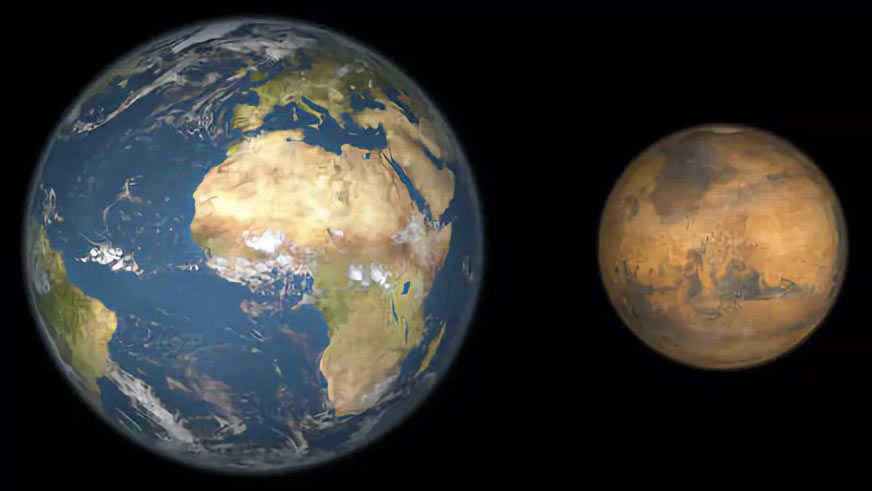
The size of Mars compared to Earth
The diameter and circumference of Mars
Despite its apparent spherical shape, Mars is actually an oblate spheroid, similar to Earth. What does this mean? It means that, like Earth, Mars rotates on its axis, causing it to flatten at the poles. While we may not notice this from the surface, an observer from space would see that Mars completes one full rotation every 24.6 hours, which is the length of a Martian day. Due to the planet’s rotation and the resulting centrifugal forces, its mass is distributed unevenly, causing it to appear “shrunken” at the poles and “expanded” at the equator.
As a result of this, Mars has a diameter of 6,794 km at the equator, but a diameter of 6,752 km from pole to pole. Therefore, the circumference of Mars at the equator is 21,343 km, while at the poles it is 21,244 km.
Mass and Gravity on Mars
The mass of Mars is 6.42 x 10^23 kg, which is approximately one-tenth of the mass of Earth. Naturally, this also affects the gravitational force. The gravitational force on Mars is only 38% of the force on Earth, meaning that a person weighing 100 kilograms on Earth would weigh 38 kilograms on Mars.
This also explains the presence of “Martian meteorites” on Earth – due to the lower gravity, it is much easier for a stone to be ejected from the surface of Mars and make its way to our planet.
Mars records
Despite its relatively small size, Mars boasts two extraordinary features that never fail to amaze: Mariner Valley and Mount Olympus.
Mariner Valley, which was discovered in 1971 by the Mariner 9 probe, is an immense system of canyons that stretches for 4,000 kilometers from east to west and reaches depths of up to 10 kilometers. To put it into perspective, if this colossal structure were located on Earth, it would span the entire length of Australia from north to south or the entire width of the United States from west to east! On Mars, the Mariner Valley covers over 1/5 of the planet’s surface, resembling a colossal scar that was left behind by a massive celestial body that collided with Mars in the distant past.
Mount Olympus is truly deserving of its title – this colossal dormant volcano towers 27 kilometers above the Martian surface, which is equivalent to three Mount Everest mountains stacked on top of each other! Mount Olympus is unparalleled in the entire solar system, as no other celestial body possesses such an immense volcano. The diameter of Olympus measures 600 kilometers. To cover this vast distance in a direct route, one would need to drive for 7 hours at a speed of 90 km/h.
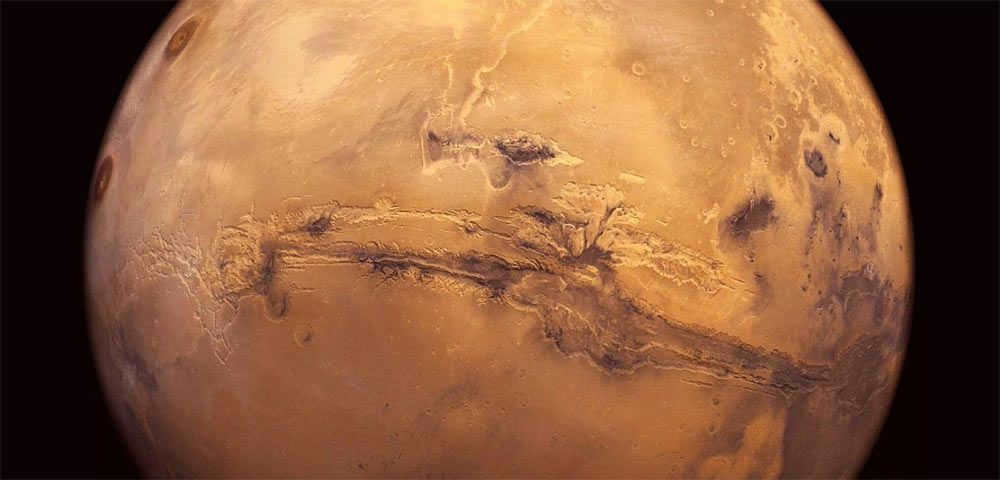

Mariner Valley is an enormous network of valleys on Mars that would be awe-inspiring even if it were on Earth
What other information do we possess concerning Mars?
Source: space.com, translation: starcatalog.ru
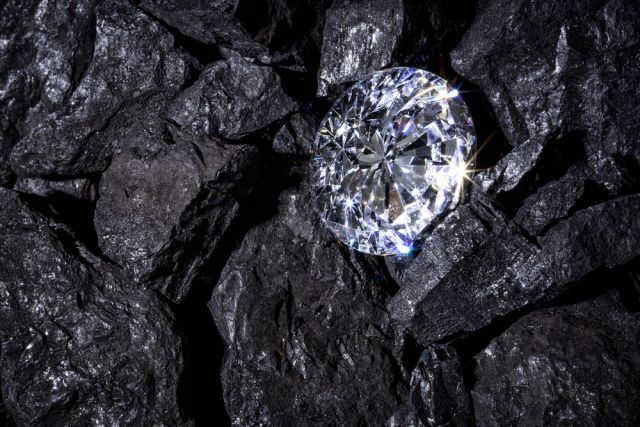
Gems with a diameter of 1 centimeter can form in the depths of Jupiter and Saturn. On Uranus and Neptune, they fall like hail. Is it possible to extract them and bring them to Earth?
According to a scientific hypothesis, the temperature and pressure in the lower parts of the atmospheres of the giant planets, Uranus and Neptune, create conditions where hydrocarbon compounds split and carbon compresses into diamonds, sinking even deeper into the cores of these planets. In other words, there are “diamond rains” on these planets.
Recently, scientists have presented new experimental data that illustrate this unusual phenomenon from the perspective of Earth’s inhabitants. The findings have been published in the journal Nature Communications.

AiF.ru interviewed Dr. Vladislav Shevchenko, the head of the department of lunar and planetary studies at the Sternberg State Astronomical Institute of Moscow State University, who explained the purpose of this research and discussed the possibility of extracting diamonds from giant planets for economic gain.
Picture a scenario where 250 elephants stepped on your fingernail
– Uranus and Neptune, the seventh and eighth farthest planets from the Sun, remain largely enigmatic. Only a single spacecraft, Voyager-2, managed to approach Uranus in 1986 after over a decade of travel, and three years later, it flew within a mere 48 thousand kilometers of Neptune. Consequently, the recent findings from laboratory simulations exploring the characteristics of these celestial entities have piqued the curiosity of astronomers.
According to modern scientific research, it has been confirmed that the atmospheres of Uranus and Neptune primarily consist of hydrogen and helium, with a small amount of methane mixed in. These two planets are classified as gas giants, meaning they do not possess a solid surface in the traditional sense. Extensive calculations have indicated that under extreme pressure and high temperatures within the planets’ interiors, methane molecules undergo a decomposition process, resulting in the formation of hydrogen and carbon. As the pressure continues to increase, reaching astronomical levels, the carbon atoms eventually transform into diamonds, descending further into the depths of the planets. Over time, these diamonds accumulate near the solid core, giving rise to the fascinating phenomenon known as “diamond rain,” or more precisely, “diamond hail.”

The process of forming crystalline structures with nanometer-scale sizes is believed to occur several thousand kilometers below the cloud layer that gives these planets their apparent size. It is worth mentioning that Uranus has an average radius of over 25.3 thousand kilometers, while Neptune’s average radius is 24.6 thousand kilometers. To illustrate the immense pressure in the interior of Uranus and Neptune, the authors of these publications offer the following comparison: imagine the pressure of 250 African elephants standing on your thumbnail at once!
Under such extreme conditions, deep within the interiors of Uranus and Neptune, nanometer-sized crystalline particles composed of carbon, which can be classified as a type of mineral known as diamonds, are formed.
Manufacturing Natural Diamonds
Scientists have successfully replicated similar conditions using powerful optical lasers and observed the real-time formation of microscopic diamond particles. The research revealed that carbon indeed transforms into crystalline diamond. Creating such a simulation proved to be incredibly challenging. A renowned physicist likened this process to making mayonnaise in reverse, where the ingredients are separated.
The experiment’s authors propose that over thousands of years, these diamond particles slowly sink into deep layers of ice and accumulate in a thick layer around the cores of massive planets. Researchers who support this theory predict that on Uranus and Neptune, the gradual growth of diamonds in the lower layer leads to a significant increase in their mass, potentially up to a million carats.
What was the reason for the experts’ keen interest in the novel findings? It is worth reiterating that astronomers are unable to investigate the internal composition of Uranus and Neptune, which hinders our overall comprehension of the solar system and the galaxy since planets of similar dimensions were abundant in the Milky Way.
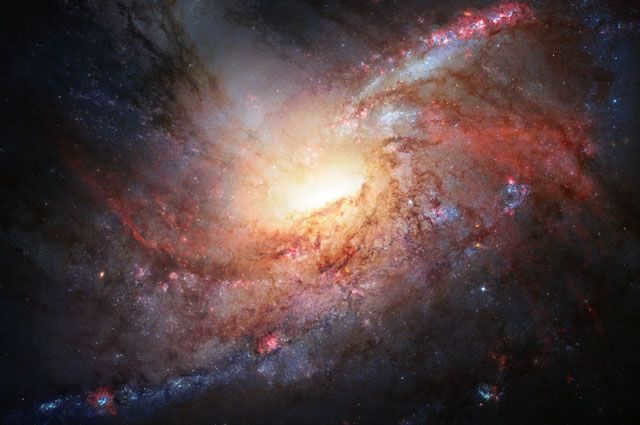
Speaking of which, Uranus and Neptune might not be the sole natural diamond factories within the Solar System. Following the publication of the aforementioned experiment’s results, astronomers have been reminded of other similar hypotheses. For instance, 7 years ago, one astronomer asserted that gemstones measuring 1 centimeter in diameter could form in the depths of Jupiter and Saturn. In these gas giants, carbon could also originate from methane, albeit through the influence of lightning strikes, which create the necessary conditions of high pressures and temperatures.
Is it possible that diamonds are formed deep within giant planets in a similar way to those that are mined here on Earth? The answer to this question remains unknown and can only be the subject of speculation. Given that the laws of nature are consistent throughout the entire universe, it stands to reason that diamonds (not in their polished, jewelry form, but as raw minerals) must exist on planets like Uranus and Neptune. However, due to the immense distance and insurmountable challenges involved in reaching the cores of these giant planets, we will never be able to witness their existence firsthand. Even future generations will likely be unable to penetrate the thousands of kilometers of planetary material that separate us from these precious resources.
Consequently, it is highly unlikely that we will ever be able to extract valuable minerals from the depths of the four giant planets in our solar system, even in the most distant future.

Jupiter, which is positioned as the fifth planet in the solar system, is commonly known to be larger and more massive than Earth. This gas giant, located at a distance of at least 630 million kilometers from Earth, is a fascinating subject for comparison. So, just how much larger is Jupiter compared to Earth? To put things into perspective, consider that Jupiter is a staggering 2.5 times more massive than all the other planets in the solar system combined.
1. The diameter of Jupiter is 11.2 times greater than that of Earth:
Jupiter has an average diameter of just under 140,000 kilometers, which is 11.2 times larger than the diameter of Earth. To put it another way, if we were to line up 11 Earth-sized planets, their combined diameter would be equal to that of Jupiter.

2- Jupiter’s volume is 1321.3 times greater than Earth’s, and its surface area is 121.9 times greater:
As the size increases, the volume of an object also increases, but not in a linear fashion: the equation for determining the volume of a sphere is V = (4/3)πR^3 = (4/3)π(11.2Rz)^3. Therefore, to find the volume of Jupiter, we would need 1321.3 Earths.
To calculate the surface area of a sphere, we use the equation S = πD^2. By substituting our value of 11.2 Earth diameters into the equation, we can determine that Jupiter’s surface area is approximately 121.9 times greater than Earth’s surface area.





